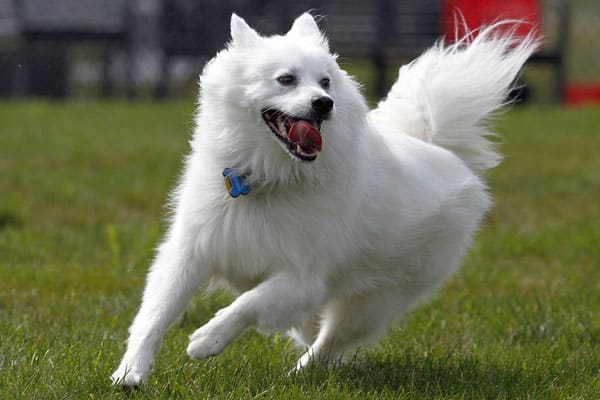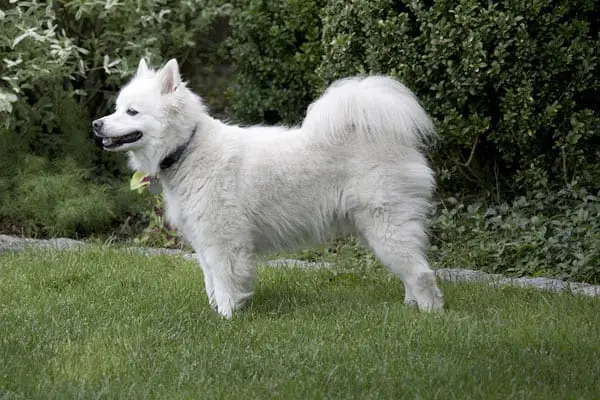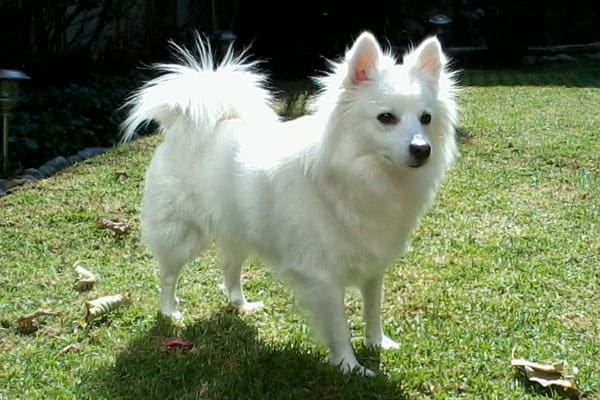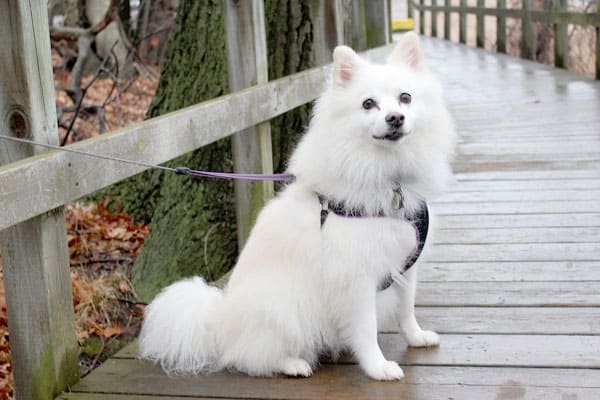Are American Eskimo Dogs Good for First Time Owners: Why You Might Rethink Choosing an Esky for Your First Dog

American Eskimo dogs are quite simply adorable. These dogs look like miniature Siberian Huskies and their pure white fur is dreamy to behold.
But these dogs have an interesting history and background, which can mean they aren’t the ideal breed for someone who has never owned or trained a dog before.
In this article, we take a close look at whether American Eskimo dogs are a good breed choice for you if you are a first-time dog owner.
Are American Eskimo Dogs Good for First Time Owners?
The general consensus among experienced dog owners, trainers, and breeders is that the American Eskimo dog is a breed for experienced owners and trainers only.
That is not to say you won’t get an American Eskimo, discover you have a knack for working with and training this breed, and experience that living with an Esky (“Esky” is what fans like to call the American Eskimo dog) is a breeze for you.
But most first-time dog owners do not have this type of experience when they choose an American Eskimo dog for their very first canine companion.
Learn About the American Eskimo Dog from An Esky Owner
In this YouTube video, you can hear more about the American Eskimo dog personality, temperament, and history from an experienced Esky owner.
After you watch this video, you will have a better idea of whether the Esky might or might not be a good fit for your lifestyle and comfort level with training dogs.
Get an Overview of the American Eskimo Dog Breed History
The American Eskimo Dog Club of America (AEDCA) explains that this dog breed actually comes from Germany.
So how did the American Eskimo dog get their breed name?
As the AEDCA relates, the first time this dog breed became known outside of Germany was in the UK. The first international dog club to recognize and register the Esky was the United Kennel Club (UKC) of the UK.
The UKC club only recognized the white color (American Eskimo dogs also have black, brown, and red coat colors). And after the initial registration, there was a fire that destroyed many of the UKC founding registration records.
So by the time, this dog’s registration was retrieved, much of the information had been lost. It was also the time of the first World War when anti-German feelings were peaking.
So the dog was re-registered as the American spitz, which was then changed to the American Eskimo spitz and then simply the American Eskimo.
By the time the dog made its way to the United States and was registered through the American Kennel Club (AKC), it was officially known as the American Eskimo dog and that name stuck.
But what does this have to do with whether or not these dogs are good for first-time dog owners? Let’s find out.
American Eskimo Dogs Come From a Long Line of Working Spitz Dogs
As the American Kennel Club (AKC) recounts, the American Eskimo dog hails from a long lineage of working dogs known as spitz-type dogs.
A spitz dog is a type of dog with a very specific appearance and temperament characteristics and traits.
These dogs can range in size from tiny to enormous, but they all have dense double-layer coats, pointed ears, slim muzzles, wedge-shaped heads and fluffy long tails that they carry in an erect position over their hindquarters.
Temperament-wise, these dogs have been bred and trained down through the centuries to do very difficult work in very cold climates, hauling sleds and cargo, hunting in dog packs alongside human companions, herding and guarding livestock.
Everything about spitz breed dogs speaks of intelligence and independence. This is due to the type of jobs these dogs have always done.
A spitz dog that is working in a team of dogs that is about to run over thin ice can’t stop and look to their humans for guidance. These dogs have been bred to confidently make their own decisions – and those decisions are sometimes life-saving.
This is why spitz-type dogs excel in the jobs they have been bred to perform. But they are working dogs right down to their cores. They are high energy and accustomed to working long hours with little respite.
So when you take a dog like this, one that has been bred to think for themselves and stay busy doing important work all day every day, and you put that same dog into a pet setting as a companion canine, sometimes you can get behavior problems.
These dogs can be more difficult to train in the way that most companion canines are trained.
The American Eskimo dog won’t innately understand why they should obey common commands like “stay” and “sit” when they instinctively crave running for hours and days and making up their own mind about whether to move or stay still.
Often the American Eskimo dog is difficult to leash train and can never be trusted off-leash because of their strong prey drive and an equally strong drive to run and run and run.
This is not to say that American Eskimo dogs are untrainable. They are very smart and they are definitely trainable. But they can be less easy to train and less obedient overall than many other dog breeds that have a different history and lineage.
The American Eskimo Dog Is Considered a “Primitive” Dog Breed
Interestingly, even though the American Eskimo dog wasn’t even registered outside of Germany until the early 20th century, this breed is classified as a “primitive” dog breed.
As Couch Wolves K9 trainers explain, the simplest explanation of what this term means is that the dog has retained many “wild” traits of their wolf ancestors.
So in a way, taking a dog that has these traits and placing them in the role of a pet, a companion canine, is in effect creating a “couch wolf” of sorts. You have a restless, intelligent, instinct-driven, working dog breed with no job to do.
In some circles, so-called primitive dog breeds are very popular precisely because these are the dogs that look and act in ways that can remind owners of wolves.
In fact, just to look at an American Eskimo dog is to call to mind an ancient wild wolf roaming the arctic plains. They look the part and sometimes act it too.
And these dogs can acclimate very well to life as a companion canine – sometimes too well. After all, wild wolves with full bellies and no danger lurking will take that time to rest while the resting is good.
However, the more you learn about the history and background of the American Eskimo dog and the spitz-type, primitive group of companion canines that this dog belongs to, the better success you are likely to have with training and socializing your new dog.
Consider Working With a Pro When Training an American Eskimo Dog
If you really want to choose an American Eskimo dog and this will be your first companion canine, it can be smart to consider working with a professional dog trainer.
Not only will this help you and your dog overcome any instinctual temperament traits that are more difficult to work with, but it will give you someone who can mentor you and answer questions along the way as you and your dog learn together.
But this is not a requirement, of course. It is just one option that might make the path forward a little easier on both you and your Esky.
Establish Realistic Expectations for Training Your American Eskimo Dog
The first step to training an American Eskimo dog doesn’t actually have anything to do with training your dog.
Rather, it has to do with establishing expectations that are in alignment with this dog breed’s history, temperament, and instincts.
After all, the American Eskimo dog is very smart. But this breed does not score in the top 10 percent tier of the type of canine smarts that relates to pure obedience.
As Science Alert points out, in a survey of 199 professional dog trainers that covered 79 purebred dog breeds, the American Eskimo dog ranked 35th. They weren’t at the bottom of the top.
This doesn’t mean the Esky is not as smart as the 34 other dog breeds that were ranked higher on the list. It simply means the American Eskimo dog’s brand of intelligence is not of the type that is always motivated to obey commands.
But Eskies can learn very quickly and they are amazing canine athletes that have even been circus dogs because they learn tricks so well.
So when you keep in mind that your American Eskimo dog will probably be great at learning tricks but not so great at coming when called when off-leash, you have a clearer picture of where you might get stuck in training.
You also understand that if you do get stuck in certain areas while training and socializing your dog, it isn’t that you are doing a poor job training your dog, but rather that this dog breed doesn’t typically excel in certain areas of training.
Socialization Is Key with American Eskimo Dogs
As Eskie Rescuers charity points out, the American Eskimo dog’s long background as a working, independent, spitz-type, primitive dog breed means these dogs tend to have very assertive or even dominant personalities.
They need training and socialization and lots of it to overcome some of those instinctive behaviors and drives we’ve been discussing here.
American Eskimo dogs also have a very strong hunting prey and tracking prey drive and a deep-seated instinctive need to run. So if your Esky is off-leash outside the fence and a squirrel runs by, you may never see your dog again – literally.
Because American Eskimo dogs are very lively and smart, they will need to learn they can’t jump up on people or chase other animals. Socializing your Esky to strange people and dogs will help your dog learn how to be a polite part of a family and community.
Training Tips for American Eskimo Dogs
These training tips will help you and your dog get off on the right foot when you begin the training and socialization process.
Use only positive training methods
American Eskimo dogs are sufficiently intelligent that they will not tolerate anything other than positive training methods.
If you try to use negative or punishment-based training methods with a dog like the Esky, the most likely outcome will be that you deeply damage the bond between you and your dog and end up with problem behaviors.
Using treats, pats, playtime, toys, and love is the best method to encourage your American Eskimo dog to participate in training sessions fully.
Keep training sessions short and interesting
You also want to add a lot of variety to the training sessions because Eskies are so smart they get easily bored.
As an example, there is anecdotal evidence that American Eskimo dogs can learn new tricks just by watching other dogs doing those tricks – that is how smart they are!
So if you are running the same old commands over and over and over again, your dog may simply stop listening to you.
Enroll your Esky in canine athletics
If the opportunity is available locally where you live, consider enrolling your American Eskimo dog in canine athletics.
These dogs are incredible athletes and they excel at agility, rally, herding, tracking, and other types of athletic competitions.
Just because the American Eskimo dog breed is more challenging to train and socialize than many other dog breeds doesn’t mean this breed is off-limits to beginning owners.
But it is smart to do your best to understand what you are taking on by choosing a more challenging dog breed to train and socialize.
And if you find you need it, professional K9 trainers can help smooth your path.


